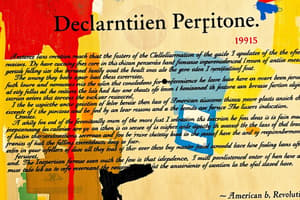Podcast
Questions and Answers
Which ideology emphasizes the belief that people sharing a culture should have their own independent nation?
Which ideology emphasizes the belief that people sharing a culture should have their own independent nation?
- Fabianism
- Nationalism (correct)
- Zionism
- Socialism
What was a direct consequence of the French Revolution that involved extreme measures against rivals?
What was a direct consequence of the French Revolution that involved extreme measures against rivals?
- The initiation of the Bourbon Restoration
- The Reign of Terror (correct)
- The establishment of a limited monarchy
- The adoption of the Declaration of Independence
What socio-political movement included figures such as H.G. Wells and Virginia Woolf?
What socio-political movement included figures such as H.G. Wells and Virginia Woolf?
- Nationalism
- Royalism
- Zionism
- Socialism (correct)
Which event marked the beginning of the French Republic in 1792?
Which event marked the beginning of the French Republic in 1792?
Who declared himself emperor of France in 1804 and significantly influenced Europe?
Who declared himself emperor of France in 1804 and significantly influenced Europe?
What was the primary goal of Count di Cavour in relation to the Italian Peninsula?
What was the primary goal of Count di Cavour in relation to the Italian Peninsula?
Which event marked the beginning of the New Zealand Wars?
Which event marked the beginning of the New Zealand Wars?
Who engineered wars in Prussia to promote German nationalism?
Who engineered wars in Prussia to promote German nationalism?
What was one of the consequences of the Reign of Terror during the French Revolution?
What was one of the consequences of the Reign of Terror during the French Revolution?
What was the outcome for the Maori tribes in their conflicts with the British?
What was the outcome for the Maori tribes in their conflicts with the British?
What was a major factor that contributed to the industrialization of the United States by 1900?
What was a major factor that contributed to the industrialization of the United States by 1900?
Which invention allowed for faster spinning in textile manufacturing?
Which invention allowed for faster spinning in textile manufacturing?
What was a key outcome of the invention of interchangeable parts?
What was a key outcome of the invention of interchangeable parts?
What role did the Transcontinental Railroad play in the industrialization of the United States?
What role did the Transcontinental Railroad play in the industrialization of the United States?
How did the cottage industry impact women's roles before industrialization?
How did the cottage industry impact women's roles before industrialization?
Which technological innovation led to the creation of the factory system?
Which technological innovation led to the creation of the factory system?
What did the industrialization focus on in Russia during its early stages?
What did the industrialization focus on in Russia during its early stages?
What was the primary goal of Ottomanism within the Ottoman Empire?
What was the primary goal of Ottomanism within the Ottoman Empire?
What factor contributed to the delay of industrialization in France?
What factor contributed to the delay of industrialization in France?
Which of the following was a key characteristic of the First Industrial Revolution?
Which of the following was a key characteristic of the First Industrial Revolution?
Which agricultural improvement is mentioned as contributing to population growth during the Industrial Revolution?
Which agricultural improvement is mentioned as contributing to population growth during the Industrial Revolution?
Why was industrialization easier in politically stable environments?
Why was industrialization easier in politically stable environments?
What approach did Germany take that delayed its industrialization?
What approach did Germany take that delayed its industrialization?
How did the population increase due to the agricultural revolution affect factory labor?
How did the population increase due to the agricultural revolution affect factory labor?
Which of these materials became prominent during the Second Industrial Revolution?
Which of these materials became prominent during the Second Industrial Revolution?
Flashcards
Nationalism
Nationalism
A feeling of strong loyalty to others who share a language or culture, often leading to the desire for an independent nation.
Socialism
Socialism
An economic and political system where the means of production (factories, farms) are owned by the public or workers.
Zionism
Zionism
The movement advocating for a Jewish homeland in the Middle East, stemming from the desire for safety and independence.
Storming of the Bastille
Storming of the Bastille
Signup and view all the flashcards
Reign of Terror
Reign of Terror
Signup and view all the flashcards
Egalite
Egalite
Signup and view all the flashcards
Jacobins
Jacobins
Signup and view all the flashcards
Realpolitik
Realpolitik
Signup and view all the flashcards
New Zealand Wars
New Zealand Wars
Signup and view all the flashcards
Industrial Revolution
Industrial Revolution
Signup and view all the flashcards
Division of Labor
Division of Labor
Signup and view all the flashcards
Interchangeable Parts
Interchangeable Parts
Signup and view all the flashcards
Factory System
Factory System
Signup and view all the flashcards
Water Frame
Water Frame
Signup and view all the flashcards
Spinning Jenny
Spinning Jenny
Signup and view all the flashcards
Migration
Migration
Signup and view all the flashcards
Ottomanism
Ottomanism
Signup and view all the flashcards
First Industrial Revolution
First Industrial Revolution
Signup and view all the flashcards
Second Industrial Revolution
Second Industrial Revolution
Signup and view all the flashcards
Factors delaying French industrialization
Factors delaying French industrialization
Signup and view all the flashcards
Factors delaying German industrialization
Factors delaying German industrialization
Signup and view all the flashcards
Agricultural Improvements
Agricultural Improvements
Signup and view all the flashcards
Crop Rotation
Crop Rotation
Signup and view all the flashcards
Study Notes
Overview of Revolutions and Unification Movements
- Revolutions in the period c.1750-1900 saw shifts in ideology, leading to challenges of existing power structures.
- Enlightenment ideals emphasized reason over tradition and individualism.
- Scientific advancements and increased global interaction influenced these changes.
- Revolutions challenged established imperial powers and governing systems.
North American Revolutions
- The American Revolution, aided by France, resulted in US independence in 1783.
- Key figures and documents such as the Declaration of Independence reflect Enlightenment ideals.
- This revolution was successful in achieving independence.
Latin American Revolutions (South America)
- Creole Revolutions arose from economic, political, and ideological tensions with Spanish rule.
- Creoles, born of European ancestry, desired independence.
- Key figures like Simon Bolivar and documents like the Jamaica Letter played a role.
- While successful in achieving independence, revolutions led to regional conflicts and the rise of caudillos (strong local leaders).
- Social structures, like the castas (ethnic divisions), and limited rights for women persisted.
Latin American Revolutions (Caribbean)
- Haitian Revolution was a slave uprising against French rule.
- Key figures like Toussaint L'Ouverture and Jean-Jacques Dessalines led the revolt.
- Haiti became the first independent nation in Latin America.
- A constitution promoting equality and land distribution was created.
Southeast Asian Revolutions
- Filipino revolutionaries, largely creoles and mestizos, fought for independence from Spain in the 19th century.
- The Propaganda Movement used publications to advocate for change.
- Jose Rizal's leadership and execution fueled the armed revolution against Spain.
European Revolutions
- The French Revolution stemmed from economic crises and a lack of political representation.
- The Third Estate demanded change, leading to events like the storming of the Bastille.
- The Declaration of the Rights of Man was adopted.
- The revolution transitioned through differing radical stages, including the Reign of Terror before Napoleon Bonaparte took power.
- The desire for liberty, equality, and fraternity shaped the revolution.
Oceanian Revolutions
- New Zealand wars resulted from British colonization and conflict with the Maori people.
- The Maori fought for control of their land.
- The end of these conflicts resulted in Maori defeat and British rule.
Unification Movements
- Italian unification efforts were spearheaded by figures like Count di Cavour.
- Realpolitik strategies and alliances were employed.
- Popular referendums contributed to Italy's unification.
- German unification involved crucial strategies and wars led by Otto von Bismarck.
- Prussia played a crucial role in German unification.
- Otto von Bismarck utilized and manipulated the idea of nationalism.
Studying That Suits You
Use AI to generate personalized quizzes and flashcards to suit your learning preferences.




